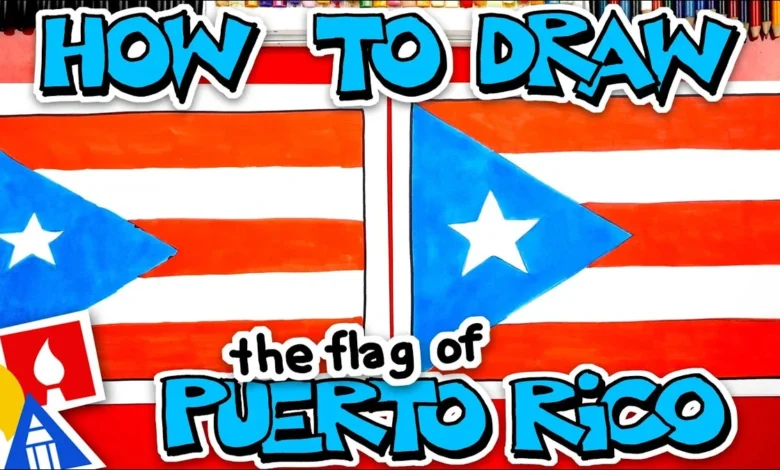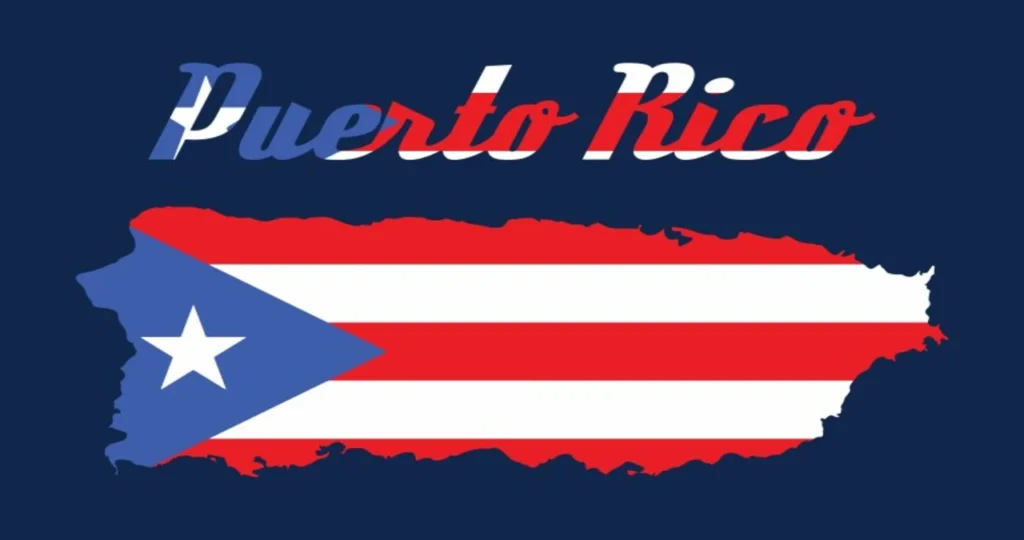Puerto Rico Flag: Symbol of Pride, Culture, and Identity1

The Puerto Rico flag, with its striking design and vibrant colors, holds immense significance for the people of Puerto Rico. It represents not just the territory’s political stance but also its rich history, culture, and identity. For many, the flag is more than just a piece of cloth—it’s a symbol of pride, resilience, and unity. In this article, we will dive deep into the meaning, history, and symbolism of the Puerto Rico flag, exploring what it stands for and why it is such an important emblem for Puerto Ricans everywhere.
The History of the Puerto Rico Flag
The origins of the Puerto Rico flag can be traced back to the late 19th century. During this time, Puerto Rico was under Spanish colonial rule, and there was a growing desire among Puerto Ricans to express their national identity and break away from foreign rule. The first official design of the Puerto Rico flag was created in 1895 by the Puerto Rican Nationalist Party, which was striving for Puerto Rican independence. The flag they designed closely resembled the flag of Cuba, to align Puerto Rico’s independence movement with that of Cuba’s.
In 1898, the United States took control of Puerto Rico after the Spanish-American War, which marked the beginning of Puerto Rico’s status as a U.S. territory. Despite this shift in governance, the flag that was first designed in 1895 continued to be a symbol of Puerto Rican pride and sovereignty. Over time, the flag has undergone minor changes, but the core design has remained largely unchanged.
The Puerto Rico flag is not just a relic of the past; it continues to be a powerful symbol for Puerto Ricans today. Whether they live on the island or in the diaspora, the flag represents a sense of belonging, pride, and cultural unity. It is displayed in homes, schools, government buildings, and at public events, reaffirming its importance in the lives of Puerto Ricans around the world.
What Does the Puerto Rico Flag Represent?
At first glance, the Puerto Rico flag may appear simple, but it is packed with meaning. The flag consists of five horizontal stripes, alternating red and white, with a blue triangle on the left side featuring a white star. Each element of the flag carries significant symbolism, representing key aspects of Puerto Rican history, culture, and values.
The Stripes: Unity and the Blood of Patriots
The five horizontal stripes on the Puerto Rico flag represent the different sectors of Puerto Rican society. Three of the stripes are red, while the other two are white. The red stripes are symbolic of the blood shed by those who fought for Puerto Rico’s freedom and independence. These patriots, many of whom were involved in struggles against Spanish colonialism, gave their lives in the pursuit of a free and self-governed Puerto Rico.
The white stripes, on the other hand, represent the peace and victory that Puerto Rico strives for. While the island has faced challenges and struggles, the white stripes symbolize the hope for a future where Puerto Ricans can live in harmony and self-determination, free from external control.
The Triangle: The Three Branches of Government
The blue triangle on the left side of the flag is another powerful symbol. The triangle is often interpreted as representing the three branches of government: the executive, legislative, and judicial. This is a reflection of Puerto Rico’s desire to maintain a balanced and fair system of governance, one that can ensure the rights and well-being of its people. The triangle also conveys a sense of stability and order, a foundation upon which Puerto Rican society can thrive.
The Star: Puerto Rico’s Independence and Sovereignty
The white star within the blue triangle is perhaps the most widely recognized feature of the Puerto Rico flag. This star symbolizes Puerto Rico’s aspiration for independence and sovereignty. While the island has been a U.S. territory for over a century, many Puerto Ricans still view the star as a beacon of their dreams for political autonomy and self-determination. The star represents the hope that Puerto Rico will one day achieve full independence or, at the very least, be granted greater political recognition and rights within the United States.
Puerto Rico Flag and Its Role in Puerto Rican Culture
The Puerto Rico flag is deeply ingrained in the island’s culture and daily life. It is seen in festivals, parades, schools, homes, and even on personal clothing and accessories. Whether it is proudly displayed at a Puerto Rican Day Parade in New York City or fluttering in the breeze at a family gathering on the island, the flag holds a central place in Puerto Rican culture.
National Pride
For Puerto Ricans, the flag is not merely a political symbol; it represents a sense of national pride and unity. Despite being a U.S. territory, many Puerto Ricans continue to identify strongly with their heritage and culture. The flag serves as a reminder of the island’s unique history, struggles, and achievements, and it instills a sense of pride in Puerto Rican identity.
At events like the annual Puerto Rican Day Parade, the flag is prominently displayed by participants from all walks of life. It serves as a unifying symbol that transcends political divisions and brings together people from different generations, regions, and backgrounds. Whether they are celebrating their culture, advocating for change, or simply showing love for Puerto Rico, Puerto Ricans wear the flag with pride.
Festivals and Traditions
Throughout Puerto Rico, there are numerous festivals and celebrations where the flag plays an important role. For example, during the annual Fiesta de la Calle San Sebastián, the streets of Old San Juan come alive with music, dancing, and vibrant displays of Puerto Rican culture. The Puerto Rico flag is commonly seen throughout the festivities, adorning parade floats, costumes, and banners.
Similarly, the flag is a central element of the many political and social movements that have taken place on the island. From the civil rights movements of the 20th century to the pro-independence demonstrations, the flag has been used as a symbol of resistance and a call for greater autonomy. Whether it is a peaceful protest or a joyful celebration, the Puerto Rico flag is an essential part of the island’s public life.

The Puerto Rico Flag and Its Political Significance
The Puerto Rican flag is not only a symbol of cultural pride; it also carries political significance. The flag has been at the center of discussions surrounding Puerto Rico’s political status, with many seeing it as a symbol of Puerto Rican independence. While the island’s relationship with the United States remains complex, the flag serves as a constant reminder of Puerto Rico’s desire for greater political autonomy.
Independence Movements and the Flag’s Role
For many Puerto Ricans, the flag represents their ongoing fight for independence from the United States. Despite the island’s status as an unincorporated U.S. territory, there has been a long history of independence movements that advocate for Puerto Rico’s political freedom. The Puerto Rico flag is often seen at rallies and demonstrations where Puerto Ricans express their desire for a future where the island is no longer bound by the policies and laws of the U.S. government.
In recent years, the Puerto Rico flag has also been a symbol for those advocating for statehood. Some Puerto Ricans believe that statehood would provide the island with greater political recognition and rights within the United States. While the flag itself is often associated with independence, it has also been embraced by those who support Puerto Rico’s eventual statehood.
The Flag as a Symbol of Resistance
Throughout Puerto Rican history, the flag has often been used as a symbol of resistance. During times of political oppression, the flag has served as a tool for expressing dissent and challenging colonial rule. From the Spanish colonial era to the U.S. occupation, the flag has been displayed as a powerful statement of Puerto Rican sovereignty. Even in the face of adversity, the Puerto Rico flag has remained a symbol of the island’s unyielding spirit and determination to maintain its cultural and political independence.
The Design Evolution of the Puerto Rico Flag
The design of the Puerto Rican flag has undergone several changes throughout its history, reflecting the political and social shifts on the island. While the flag’s core elements—such as the red and white stripes and the blue triangle with the white star—have remained largely unchanged, there have been some notable modifications over the years.
The First Flag Design
The first version of the Puerto Rico flag was created in 1895 by the Puerto Rican Nationalist Party. This flag closely resembled the Cuban flag and was intended to symbolize solidarity between the two territories, both of which were struggling for independence from Spanish rule. This design was initially used as a symbol of Puerto Rican nationalism, although it was not officially recognized by the Spanish authorities.
Modifications Under U.S. Control
After the United States took control of Puerto Rico in 1898, the flag underwent some changes. The U.S. government did not officially recognize the Puerto Rican flag for several decades, and it was not until 1952 that the flag was formally adopted as the official flag of the Commonwealth of Puerto Rico. The flag’s design was slightly altered during this time, most notably with the addition of a larger and more distinct star in the blue triangle.
Today’s Flag
The Puerto Rico flag in its current form is a testament to the island’s enduring struggle for freedom, sovereignty, and cultural identity. Despite challenges and controversies over the years, the flag remains a cherished symbol of Puerto Rican pride. It is displayed not only in Puerto Rico but across the world, in the homes and hearts of Puerto Ricans living abroad.
The Puerto Rico Flag and Its Global Presence
The Puerto Rico flag is not confined to the island. It has become a powerful symbol of Puerto Rican identity across the world, especially in the United States, where millions of Puerto Ricans live. Whether in New York, Chicago, or Miami, the flag is a common sight during festivals, protests, and public celebrations.
Puerto Ricans living outside of Puerto Rico have long faced challenges in maintaining their cultural identity, but the flag provides a sense of connection to their roots. It is not just a symbol of the island; it is a symbol of the Puerto Rican community as a whole, regardless of where they live. The flag serves as a beacon of unity for Puerto Ricans in the diaspora, a reminder of their shared heritage and their ongoing fight for justice and recognition.
Conclusion
The Puerto Rico flag is much more than a mere national emblem. It is a powerful symbol of Puerto Rican pride, culture, history, and the ongoing struggle for political and cultural autonomy. With its rich design and deep symbolism, the Puerto Rico flag continues to inspire Puerto Ricans everywhere, whether they live on the island or abroad. Whether displayed at a local parade, in the halls of government, or the homes of Puerto Rican families, the flag serves as a constant reminder of the island’s strength, resilience, and unwavering commitment to its people and culture.



